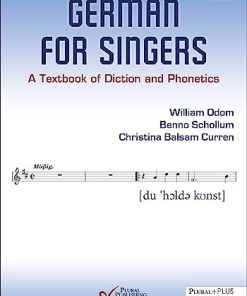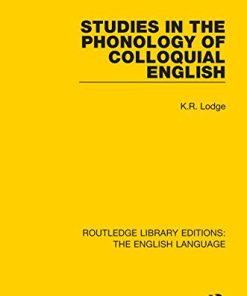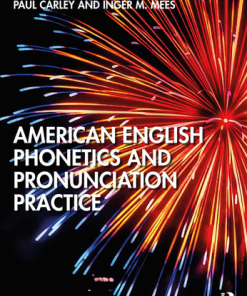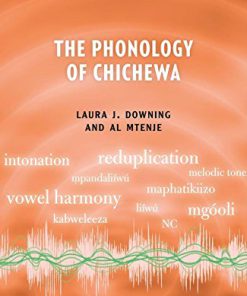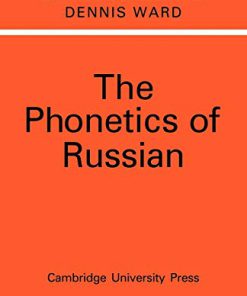The phonetics and phonology of geminate consonants 1st Edition by Haruo Kubozono 0198754930 9780198754930
$50.00 Original price was: $50.00.$25.00Current price is: $25.00.
The phonetics and phonology of geminate consonants 1st Edition by Haruo Kubozono – Ebook PDF Instant Download/Delivery: 0198754930, 9780198754930
Full download The phonetics and phonology of geminate consonants 1st Edition after payment

Product details:
ISBN 10: 0198754930
ISBN 13: 9780198754930
Author: Haruo Kubozono
This book is the first volume specifically devoted to the phonetics and phonology of geminate consonants, a feature of many of the world’s languages including Arabic, Bengali, Finnish, Hungarian, Italian, Japanese, Malayalam, Persian, Saami, Swiss German, and Turkish. While the contrast between geminate and singleton consonants has been widely studied, the phonetic manifestation and phonological nature of geminate consonants, as well as their cross-linguistic similarities and differences, are not fully understood. The volume brings together original data and novel analyses of geminate consonants in a variety of languages across the world. Experts in the field present a wide range of approaches to the study of phonological contrasts in general by introducing various experimental and non-experimental methodologies; they also discuss phonological contrasts in a wider context and examine the behaviour of geminate consonants in loanword phonology and language acquisition. The volume takes an interdisciplinary approach, drawing on experimental phonetics, theoretical phonology, speech processing, neurolinguistics, and language acquisition.
The phonetics and phonology of geminate consonants 1st table of contents:
Part I: Production and perception of geminate consonants
1: Spectral continuity, amplitude changes, and perception of length contrasts
1.1 Introduction
1.1.1 Synopsis
1.1.2 Japanese
1.1.3 Other languages
1.2 The phonetic grounding of the dispreference for sonorant geminates
1.2.1 Hypothesis
1.2.2 Some caveats
1.3 Experiment I. Discrimination experiment: obstruents vs. sonorants
1.3.1 Introduction
1.3.2 Method
1.3.2.1 Stimuli
1.3.2.2 Procedure
1.3.2.3 Participants
1.3.2.4 Analysis
1.3.3 Results
1.3.4 Discussion
1.4 Experiment II. Identification experiment: obstruents vs. sonorants
1.4.1 Introduction
1.4.2 Method
1.4.2.1 Procedure
1.4.2.2 Participants
1.4.2.3 Analysis
1.4.3 Results
1.4.4 Discussion
1.5 Experiment III. Discrimination experiment: nasals vs. glides
1.5.1 Method
1.5.1.1 Stimuli
1.5.1.2 Other aspects of the experiment
1.5.2 Results and discussion
1.6 Experiment IV. Identification experiment: nasals vs. glides
1.6.1 Method
1.6.2 Results and discussion
1.7 General discussion
1.7.1 Summary
1.7.2 Implications for the phonetics-phonology interface
1.7.3 Remaining questions
Acknowledgements
2: Production of geminate consonants in Russian: Implications for typology
2.1 Introduction
2.1.1 Conditioning factors and geminate duration across languages
2.1.2 Russian geminates
2.2 Experiment I
2.2.1 Methods
2.2.1.1 Corpus and measurements
2.2.1.2 Participants
2.2.1.3 Procedure
2.2.2 Results
2.2.2.1 Distribution of underlying geminates in the corpus
2.2.2.2 Acoustic duration and rates of degemination
Geminate status
Contextual position
Stress position
Consonant type
Morphological status
2.2.3 Discussion
2.3 Experiment II
2.3.1 Methods
2.3.1.1 Stimuli
2.3.1.2 Participants
2.3.1.3 Procedure
2.3.1.4 Measurements
2.3.1.5 Analysis
2.3.2 Results
2.3.2.1 Segmental environment
2.3.2.2 Word-edge position
2.3.2.3 Stress position
2.3.2.4 Consonant type
2.3.3 Discussion
Acknowledgements
3: Word-initial geminates: From production to perception
3.1 Introduction
3.2 Word-initial geminates: production
3.3 Word-initial geminates: perception
3.3.1 Method
3.3.1.1 Participants
3.3.1.2 Stimuli
3.3.1.3 Procedure
3.3.2 Results
3.4 Summary and general discussion
4: Effects of duration and phonological length of the preceding/following segments on perception of
4.1 Introduction
4.1.1 Studies on temporal relationship between vowels and the following consonants
4.1.2 Confounding factors and interpretations
4.1.3 Effects of the duration/length of the following consonant on the perception of vowel length
4.1.4 Aims of the current study
4.2 Experiment 1. Perception of vowel and consonant length in Japanese
4.2.1 Participants
4.2.2 Stimuli and procedure
4.2.3 Results
4.2.3.1 Singleton/geminate stop perception
4.2.3.2 Short/Long vowel perception
4.2.4 Discussion
4.2.4.1 Singleton/geminate stop perception
4.2.4.2 Short/long vowel perception
4.3 Experiment 2: Production experiment
4.3.1 Participants
4.3.2 Procedure
4.3.3 Analyses and predictions
4.3.4 Results
4.3.4.1 V1 duration
4.3.4.2 C2 closure duration
4.3.5 Discussion
4.4 General discussion
4.4.1 Perceptual cues for singletons/geminate
4.4.2 Assimilative effects in Japanese
4.5 Conclusions
4.6 Appendix. Results of acoustical analyses (Experiment 2): mean durations and SDs of each segment
Acknowledgements
5: Articulatory coordination in long and short consonants: An effect of rhythm class?
5.1 Introduction
5.2 Methods
5.2.1 Speakers
5.2.2 Linguistic material
5.2.3 Movement recording
5.3 Results
5.3.1 Onset of tongue body movement relative to onset of oral closure
5.3.2 Onset of tongue-body movement relative to onset of lip movement for closure
5.3.3 Offset of tongue body movement relative to oral release
5.4 Discussion
Acknowledgements
6: The acquisition of long consonants in Norwegian
6.1 Introduction
6.1.1 Geminate acquisition
6.1.2 Long consonants in Norwegian
6.1.3 Rationale for study
6.2 Method
6.2.1 Participants
6.2.2 Materials and elicitation
6.2.3 Analysis
6.2.3.1 Segmentation and measurement
6.2.3.2 Periods of preaspiration
6.2.3.3 Statistical analysis
6.3 Results
6.3.1 Sonorants
6.3.1.1 V1
6.3.1.2 C
6.3.1.3 Long:short comparisons
6.3.1.4 V/VC
6.3.2 Voiceless stops
6.3.2.1 Preaspiration
6.3.2.2 Temporal analysis
V1
C
Long:short comparisons
V/VC
6.4 Discussion
6.4.1 Temporal cues
6.4.1.1 Sonorants
6.4.1.2 Voiceless stops
6.4.2 Determining the location and nature of the contrast
6.4.3 Preaspiration
6.5 Conclusion
6.6 Appendix. Target words
Acknowledgements
7: Second language learners´ production of geminate consonants in Japanese
7.1 Introduction
7.2 Method
7.2.1 Participants
7.2.2 Stimuli and procedure
7.2.3 Measurement and analyses
7.3 Results
7.3.1 Sentence duration
7.3.2 Stop closure duration
7.3.3 G/S ratio
7.3.4 C/V1 ratio: ANOVA
7.3.5 C/V1 ratio: classification accuracy
7.3.6 Word duration
7.3.7 C/W ratio: ANOVA
7.3.8 C/W ratio: classification accuracy
7.3.9 Individual speaker performances
7.4 Discussion and conclusions
Part II: Phonology of geminate consonants
8: Bengali geminates: Processing and representation
8.1 Why geminates?
8.1.1 An inventory of Bengali geminates
8.1.2 Gemination as a productive process in Bengali
8.1.3 Acoustic and perceptual correlates of Bengali geminates
8.2 Representation of consonantal duration
8.2.1 Geminates: one segment or two?
8.2.2 Processing and geminate representation
8.3 Experimental evidence for the representation and processing of Bengali geminates
8.3.1 Two early studies
8.3.2 Recognition of words containing singletons vs. geminates
8.3.2.1 Behavioural studies
8.3.2.2 Neurolinguistic evidence: an N400 study
8.4 Discussion
Acknowledgements
9: Asymmetric processing of consonant duration in Swiss German
9.1 Introduction
9.2 Why geminates are special
9.2.1 Phonetic characteristics of geminates
9.2.2 Geminates in Swiss German
9.3 Geminates in the mental lexicon
9.4 Asymmetric processing of consonant duration in Swiss German
9.4.1 Experiment design and materials
9.4.2 Participants
9.4.3 Procedure
9.4.4 Behavioural and ERP data collection
9.4.5 ERP data processing
9.4.6 Results
9.4.6.1 Behavioural data
9.4.6.2 ERP data
9.5 Discussion
9.5.1 Representational account: a structurally underspecified geminate/singleton contrast
9.5.2 Processing account: a CV template in parsing
9.5.3 Swiss German speakers integrate durational variation
9.5.4 Open questions
9.6 Conclusion
Acknowledgements
10: Geminates and weight-manipulating phonology in Chuukese (Trukese)
10.1 Introduction
10.2 The moraicity of geminate consonants in Chuukese: data
10.3 Final mora deletion and compensatory lengthening
10.4 Geminate throwback
10.5 Apparent exceptions and lexical variation
10.6 Conclusion
Acknowledgements
11: On the weight of edge geminates
11.1 Introduction
11.2 Final geminates
11.2.1 Combinations of moraic final geminates and clusters
11.2.1.1 Pattern I: languages with moraic final geminates and no final clusters
11.2.1.2 Pattern II: languages with moraic final geminates and moraic final clusters
11.2.1.3 Pattern III: languages with moraic final geminates and non-moraic final clusters
11.2.2 Combinations of non-moraic final geminates and clusters (Patterns IV-VI)
11.3 Initial geminates
11.3.1 Combinations of moraic initial geminates and clusters
11.3.1.1 Pattern VII: languages with moraic initial geminates and no initial clusters
11.3.1.2 Pattern VIII: languages with moraic initial geminates and moraic initial clusters
11.3.1.3 Pattern IX: languages with moraic initial geminates and non-moraic initial clusters
11.3.2 Combinations of non-moraic initial geminates and clusters
11.4 Discussion: asymmetries and gaps in the typology of edge geminates
11.5 Conclusion
Acknowledgements
12: A prosodic account of consonant gemination in Japanese loanwords
12.1 Introduction
12.2 Basic structures of native Japanese phonology
12.2.1 Segmental length
12.2.2 Syllable structure constraints
12.2.3 Prosodic form
12.2.4 Accent structure
12.3 Gemination vs. non-gemination
12.4 Segmental conditions on gemination
12.4.1 Voicing
12.4.2 Sonorancy
12.4.3 Place of articulation
12.4.4 Manner of articulation
12.5 Prosodic conditions on gemination
12.5.1 Prosodic faithfulness I: word-final vs. word-internal codas
12.5.2 Prosodic markedness I: NonFinality
12.5.3 Prosodic markedness II: InitialFoot
12.5.4 Prosodic faithfulness II: ProsodicIntegrity
12.6 Summary and conclusion
Acknowledgements
13: The relation between L2 perception and L1 phonology in Japanese loanwords: An analysis of gemina
13.1 Introduction
13.1.1 General background
13.1.2 Geminate consonants in loanwords from English
13.1.3 Geminate consonants in Italian
13.2 Corpus study: geminates in loanwords from Italian
13.3 Perception of geminates and singletons in Italian words by Japanese speakers
13.4 Discussion and conclusions
Acknowledgements
14: Korean speakers´ perception of Japanese geminates: Evidence for an L1 grammar-driven borrowing
14.1 Introduction
14.2 Methods
14.3 Results
14.4 Discussion
14.5 Theoretical implications
14.6 Conclusion
14.7 Appendices
14.7.1Appendix A. The distribution of no coda, coda /s/, /t/, /p/, and /k/ in Seoul Korean speakers
14.7.2 Appendix B. The distribution of onset lenis, fortis, aspirated, and other consonants in Seoul
14.7.3 Appendix C. References to tourism in our survey of Korean adaptation of Japanese geminates
People also search for The phonetics and phonology of geminate consonants 1st:
in the study of phonetics consonant phonemes are classified by
phonetics the consonants p b m w are known as
phonetics the consonants p b m w
consonant gemination
consonant phonemes are classified by
Tags: The phonetics, phonology, geminate consonants, Haruo Kubozono
You may also like…
dictionaries & phrasebooks
Studies in the Phonology of Colloquial English 1st Edition by Lodge ISBN 131743773X 9781317437734
dictionaries & phrasebooks
dictionaries & phrasebooks
American English Phonetics and Pronunciation Practice Paul Carley
dictionaries & phrasebooks
The Phonology of Chichewa 1st Edition by Laura Downing, Al Mtenje 0191037733 9780191037733
Languages - Russian Language Reference
The Phonetics of Russian 1st edition by Jones Daniel Ward Dennis 1783082681 9781783082681
Uncategorized
Physics and Chemistry of Carbon-Based Materials: Basics and Applications Yoshihiro Kubozono




